- Home
- Stephen Baxter
Phase Space Page 18
Phase Space Read online
Page 18
Slade got out of his chair. His back and shoulders were stiff; he worked his fingers and arms to loosen up the muscles.
A tech was slapping him on the back. ‘How about that,’ he said. ‘Just as fat as a goose. Outstanding.’
‘Yeah. Outstanding.’
Slade stepped out of the trailer. It was still bright morning; the flight had lasted just minutes. And in the sky, that big old Moon hadn’t yet set; it just hung there – oh, hell, something must be wrong with his eyes, he spent too much time peering at those damn computer screens – the Moon was bright red …
… red in the light of the sun, which has swollen to a crimson giant in its old age, its hot breath suffocating the First World – and yet, paradoxically, scattering life over our own more remote globe.
How would First World life function?
It is possible water could play the role in a life system that ammonia does for us: a water-based biosphere!
First World life forms would drink water as we do ammonia, and breathe oxygen as we do nitrogen. When we respire, we burn methane in nitrogen, producing ammonia and cyanogen. Similarly, the First World life would burn sugars in oxygen and give off water and carbon dioxide. To close the loop there would be some form of photosynthesis, hydrous plants using solar energy to turn the products of that respiration – water and carbon dioxide – back to sugars and oxygen, as our plants turn ammonia and cyanogen back to methane and nitrogen …
Strange, but not impossible!
What would the First World have been like, in those remote days?
It would be a world of water oceans, perhaps with caps of polar ice, and a clear air, of free oxygen buffered by nitrogen. And there would be clouds, of water vapour …
On such a large world, spinning sixteen times as fast as Home, the climate would be more complex than our own. Powerful Coriolis forces would act on the air, generating swirling storms … We can only imagine the cultures and ecosystems which evolved in such complex and violent climatic conditions.
There is more. Chemical reactions are dependent on temperature. Reaction rates are increased as the temperature rises. On a world so warm that even water is a liquid the reaction rates rocket, by perhaps a hundred to a thousand times.
Thus, the metabolism of hydrous creatures would proceed at a much faster rate than ours. That would be offset by the increased gravity, but still, life must have proceeded at a frenetic pace.
We can even deduce the colour of the sky, on that strange, lost world.
There was no methane in the air, because it would have reacted with the free oxygen. And because light from the blue end of the spectrum has a wavelength similar in size to the molecules of the air – nitrogen and oxygen – the sky of the First World must have been blue, not green …
At last, the First World was betrayed by the star that gave it life. The end came when the surface grew so hot that the very stuff of water-based life – complex molecules and carbon-based molecular chains – was broken down.
Finally those unlikely water oceans boiled, and huge clouds of vapour were suspended in the atmosphere, driving temperatures higher still, ever faster. But even the clouds did not last forever. At last the water vapour in the air was broken up by energetic sunlight and the hydrogen driven off into space, leaving a planet baked dry, its surface cracked and flattened under a dense, sluggish atmosphere, utterly lifeless –
In any event it seems clear that my putative water-laden Moon voyagers did not have the means to escape their planet, or to avert their ultimate doom.
Trips to the Moon: logic was not enough! My simulation had taught me that, at least. ‘Logic’ to these creatures meant starving their projects of resources! And besides, nobody logical would attempt to travel between this world and its Moon with such primitive technology. Nobody sensible.
But these people were neither logical nor sensible. I knew I must remember that.
I sought a logical political structure in their reconstructed history, a structure that could have commanded significant resources. I reset the parameters of the simulation –
But I was speaking of my search for evidence of spaceflight by this antique intelligence, of its travel to the desiccated satellite:
The inner system, at the bottom of the sun’s gravity well, is crowded. Conditions are quite unlike Home, which is, of course, the largest satellite of the Fourth World. (Although, it is not well known, once the Fourth World sported a gigantic ring system, made up of chunks of ice and other debris, residue from the formation of the sun. The rings must have been beautiful. But they have long since evaporated, as the sun’s heat roared in the faces of its children –)
I digress.
The First World, then, swims through a cloud of debris, of thousands of planetesimals left over from the untidy formation of the system, aeons ago. Despite geological smoothing, its surface shows the evidence of repeated bombardment, which has diminished but not ceased with the passing of time. Its airless satellite is scarred still more impressively.
I studied the orbital characteristics of one such planetesimal in particular. Many of these objects had orbits close to or crossing the First World’s. But in this case, the parameters were so close to those of the First World that I grew suspicious.
Then excited.
Could this be the artefact I had sought? Not on the surface of either world – but some form of abandoned spacecraft, or space colony, circling the sun with its mother planet?
I scraped together funding for a mission to the anomalous planetesimal: a small ship to sail through the light of the Moon …
… the light of the Moon which shone like a torch beam into the dormitory as Slade woke, reluctantly. Already the older men were moving around him, shuffling, conserving what energy they had.
The mornings were the worst.
Everything was slow here – even dressing was slow – and Slade was hungry by the start of his work, at five a.m. And yet he would receive nothing but his soup, at two in the afternoon.
It was 1946. Slade was sixteen years old.
Slade lay in his rat-chewed blanket as long as he could.
Today was worse than usual. He felt – strange.
As if he shouldn’t be here.
He couldn’t stay on his rough pallet.
Soon would come the rush into the smoking mouth of the tunnel into the mountain, with the SS guards lashing out with their sticks and fists at the heads and shoulders of the worker herd which passed them. That tunnel was like Hell itself, with prisoners made white with dust and laden with rubble, cement bags, girders and boxes, and the corpses of the night being dragged by their feet from the sleep galleries –
When he got up he had to hurry. Otherwise he would not witness the hangings, and that was against regulations.
Actually, the hangings seemed wasteful to Slade. A victim would be gagged with a metal bar across the mouth, and the bar tied at the back of the head with wire, drawn in so tightly that the metal gag would bend, and the wire cut into the flesh of the face.
So much metal!
It was well known among the workers within the Mittelwerk that Hitler had ordered the production of no less than twenty thousand of von Braun’s A-4 rockets – or rather, what the Germans now called their V-2: V for Vergeltungswaffe, revenge weapon. And then there was the demand for thousands more of the ambitious V-3s, the A-4b design with the nuclear-tipped glider on its nose, capable of skipping across the Atlantic and digging more glowing craters into the eastern seaboard of defeated America.
How could this immense production operation spare so much metal on mere hangings?
But then – thanks to those very rockets of von Braun, which had subdued Europe and Asia and fended off America – Hitler could now exploit the resources of two continents. A little hanging wire was nothing.
Slade performed such calculations, even as he reflected on the fact that at the next roll call it could be him, suspended up there like a chicken in a butcher’s shop.
At sixteen, Slade was prized by the supervisors for his ability for skilled work. So he was assigned to lighter, more complex tasks. In the process he was forced to absorb a little German. So, gradually, he picked up something of the nature of the great machines on which he toiled, and learned of the visions of the Reich’s military planners.
They would construct an immense dome at the Pas de Calais – sixty thousand tons of concrete – from which rocket planes would be fired off at America in batches of fourteen at once. And then there were the further schemes: of hurling rockets from submarine craft, of greater rockets like von Braun’s A-9, which might hurl a man into orbit in a glider-like capsule, and – the greatest dream of all! – of a huge station orbiting five thousand miles above the Earth and bearing a huge mirror capable of reflecting sunlight, so that cities would flash to smoke and oceans might boil.
Thus would be secured the future of the Reich for a millennium.
And when that was done, von Braun talked of flights beyond Earth itself, in new generations of his giant rockets, hurled upwards by brute force: even of a nuclear-launched spaceship called Sun God which would send Germans to the Moon by 1955, to Mars a mere decade later.
Such visions!
But for Slade the V-2 was the daily, extraordinary reality. That great, finned bullet-shape – no less than forty-seven feet long – was capable of carrying a warhead of more than two thousand pounds across two hundred miles! Its four tons of metal contained no less than twenty-two thousand components! And so on.
Slade came to love the V-2.
It was magnificent, a machine from another world, from a bright future – and the true dream inherent in its lines, the dream of its designers, was obvious to him. Even as it slowly killed him.
One day, in the sleek, curving hide of a rocket ship, he caught a glimpse of his own reflection.
He looked into his own eyes unexpectedly, suddenly fully aware of himself. He had a sense of the here and now – or rather of vividness, as if the casual numbness of his life had been lifted, briefly. He hadn’t seen a mirror in three years, since the Nazis swept through what was left of Britain, and he was separated from his parents and, as an American, rounded up as an enemy alien.
He saw a skinny, half-bald kid, with blood running down his cheek from some wound he hadn’t even noticed.
– and an old man, his face twisted down under a coating of desert gypsum –
– and a gold visor, a glaring landscape reflected there –
– and flames –
Visions. It was probably the hunger. What else could it be?
He subsided to numbness, and dreams.
One morning, so early that the stars still shone and frost coated the ground, he saw the engineers from the research facility at Peenemunde – Wernher von Braun, Walter Riedel and the rest, smartly uniformed young men, some not much older than Slade – looking up at the stars, and pointing, and talking softly.
Slade glanced up, to see where they were looking. It was the crescent Moon, dimmed by the smoky light of some town which burned on the horizon. And there was the dream which motivated and sustained these young, clever Germans: that one day the disc of the Moon would be lit up with cities built by men – Germans, carried there by some gigantic descendant of the V-2.
Slade could understand how these young men from Peenemunde were blinded by the dazzling beauty of their V-2 and what it represented. But Slade was no rocket engineer; he was no more than garbage, just one of the thirty thousand French, Russians, Czechs, Poles, British and Americans who toiled inside this carved-out mountain. And in the dormitories at night would come the whispers, schemes of hidden weapons and tools, the uprising to come which would shatter the Reich.
The duality of it crushed Slade. Was such squalor and agony the inevitable price to be paid for the dream of spaceflight?
But perhaps it was. Perhaps only the organization of all of mankind’s resources, under some such system as Hitler’s, was capable of breaking the bonds of gravity. Perhaps it was necessary for von Braun’s beautiful ships to rise from ground soaked by the blood of thousands of slave workers like himself, with expended human souls burning like sparks in the gaping rocket nozzles.
How he envied the young engineers from Peenemunde, who strutted about the Mittelwerk in their smart uniforms; they seemed to find it an easy thing to brush past the stacks of corpses piled up for daily collection, the people gaunt as skeletons toiling around the great metal spaceships!
He even imagined how it would have been had he been born to become one of these smart young Germans in their SS uniforms. How he envied them! And a part of him hoped that they could achieve some piece of their huge dreams before the inevitable tide of anger rose up and swept them all to the gallows.
When he immersed himself in such dreams, something of his own, daily pain would fall from him, and he could lift his head to the Moonlight …
… the Moonlight which washed over the machined surface of my planetesimal. The object was small. But even at a great distance from it, I could detect its artificial nature.
It was a slim cylinder. One end was domed, the other terminated by a complex encrustation of equipment, including a flaring nozzle. It bore no markings.
It tumbled slowly.
It was extremely old. Sublimation had left its aluminium skin so thin it was, in places, almost transparent. In fact the hull was punctured, after billions of orbits around the sun.
The artefact was fortunate to have survived intact at all.
I approached cautiously. I could see into its interior, through rents and dimples in the hull. There was some form of double chamber in there. There was no sign of activity, of light, of energy.
The cylinder dwarfed my craft.
After circling its exterior, I gathered my courage, and I approached the terminal dome, where an eroded breach afforded me access.
I found myself rising into a cylindrical chamber, up from the cup of the dome. Stars and ruddy sunlight gleamed through hull rents. Far above me, hanging down as if swollen, I saw another dome.
The chamber was all but empty. The walls were lined with small pieces of equipment: spherical casks, ducts, pipes.
I rose through the silent grandeur of the artefact.
I passed through the upper dome, deep into the heart of the artefact. I entered a second chamber, braced with a metal frame. It was much smaller than the first.
There was no sign of occupation, no evidence of life.
I continued my inspection, baffled – at first – as to the purpose of this artefact.
But soon I formed an hypothesis.
My rogue planetesimal was clearly an artefact. But I had misinterpreted its nature.
It was no spaceborne habitat. Those great cylindrical chambers were tanks, which once bore fuel. Liquid fuel.
I came to believe the artefact was a crude rocket. It must have driven itself forward by burning liquid-chemical propellants together, and allowing the expansion of gases through the terminal nozzle. The dimensions of the tanks were consistent with the relative densities of liquid hydrogen and liquid oxygen. These would burn vigorously together, if appropriately controlled.
I elaborated my original hypothesis:
I argued that the creatures of the First World had used chemical rockets like this one to escape from their planet’s gravity well, and to travel to their satellite.
Yes – chemical rockets!
Well, I was mocked, as I might have expected. I concede it seems absurd that such a journey might be attempted with such limited technology.
But it is not impossible!
I argued my case. I was disciplined, for neglecting my primary studies.
So I determined to prove, by dramatic demonstration, how such a flight could have been achieved! I would reconstruct the chemical Moon ships from the dawn of time, and prove it was this way.
That was the start of it. But soon my simulations were going badly.
Perhaps I continued to miscalculate t
he natures of my subjects.
They were not like us.
We must remember the environment in which these bizarre animals evolved: the ferocious gravitational field of their parent world, the blistering outpourings of the nearby sun. They would be stunted, very alien creatures, warped by these enormous forces into miserably malformed, distorted shapes, crushed until they are blind and tiny. We inhabit a favoured realm, drifting far above the range of those immense forces, on our small moon so far from the sun; we should not envy these creatures their short, pain-filled lives.
But they must have been squabbling, water-stuffed, energy-fat, demon-obsessed monsters! If logic would not motivate them, if they were unable to govern themselves and their resources without brutality and waste, I knew I must try illogic.
I reset the parameters of my simulation once again. I would not rest until I had reconstructed the hydrate creatures from so long ago, sailing to the Moon …
… Sailing to the Moon, Slade was working through a plastic bag of chicken soup. He took a spoonful of the soup, tapped the handle, and the glob of soup floated off, still holding the shape of the spoon. But when he poked the liquid with a fingertip, surface tension hauled it quickly into a perfect, oscillating sphere. Slade leaned over to suck it into his mouth, a little green ball of chicken soup.
It was Slade’s fourth spaceflight, in six years. He’d never yet got bored with the zero-gravity environment.
The two other crew – Lunar Module Pilot Bado, and Command Module Pilot Pond – ate without talking. And that was the way Mission Commander Slade, in his centre couch, preferred it.
It was August, 1967. And Apollo 3 was heading for the Moon.
A splinter of crimson-sunset light, from the Command Module’s windows above him, caught Slade’s eye. He looked up. Whatever it was had gone; the windows were just rectangles of darkness.
The red of the Moon had been like –
– the red of an old man’s rheumy eyes, peering across some Godforsaken desert –

 The Martian in the Wood
The Martian in the Wood THE H-BOMB GIRL
THE H-BOMB GIRL World Engine
World Engine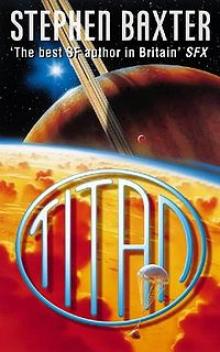 Titan n-2
Titan n-2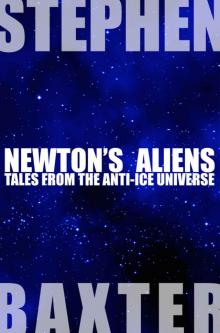 Newton's Aliens: Tales From the Anti-Ice Universe
Newton's Aliens: Tales From the Anti-Ice Universe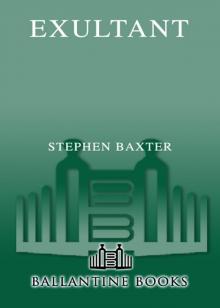 Exultant
Exultant Manifold: Origin
Manifold: Origin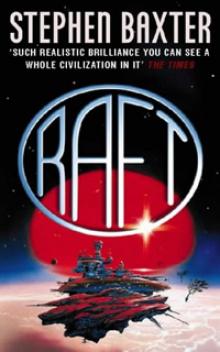 Raft xs-1
Raft xs-1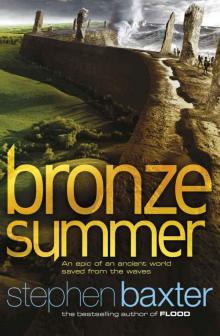 Bronze Summer n-2
Bronze Summer n-2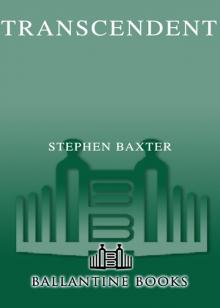 Transcendent
Transcendent Stone Spring
Stone Spring Coalescent
Coalescent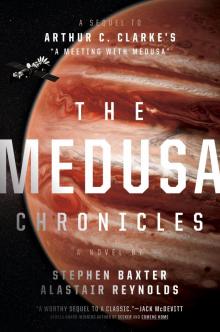 The Medusa Chronicles
The Medusa Chronicles Origin m-3
Origin m-3 Silverhair tm-1
Silverhair tm-1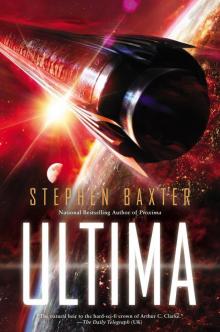 Ultima
Ultima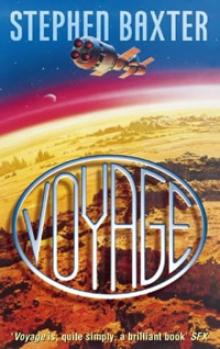 Voyage n-1
Voyage n-1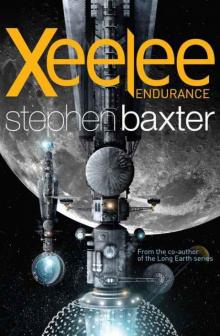 Xeelee: Endurance
Xeelee: Endurance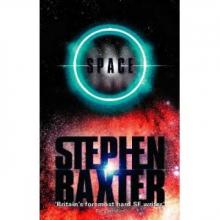 Space m-2
Space m-2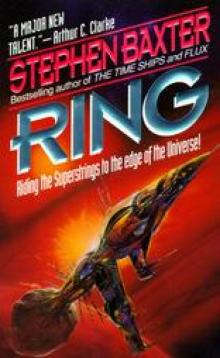 Ring xs-4
Ring xs-4 Raft
Raft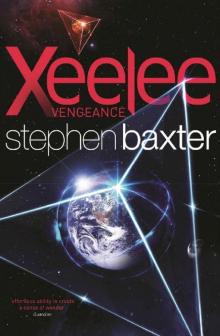 Xeelee: Vengeance
Xeelee: Vengeance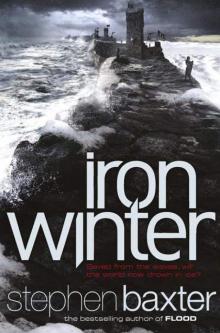 Iron Winter n-3
Iron Winter n-3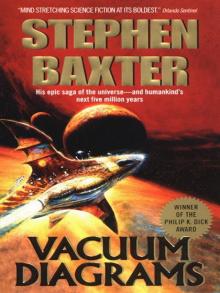 Vacuum Diagrams
Vacuum Diagrams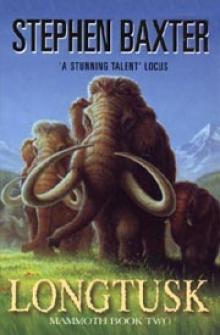 Longtusk tm-2
Longtusk tm-2 Proxima
Proxima Evolution
Evolution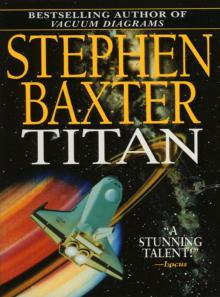 Titan
Titan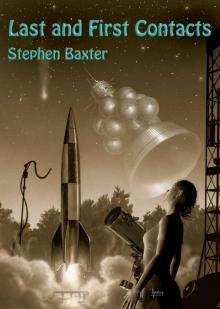 Last and First Contacts (Imaginings)
Last and First Contacts (Imaginings) Emperor
Emperor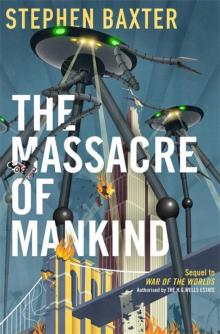 The Massacre of Mankind
The Massacre of Mankind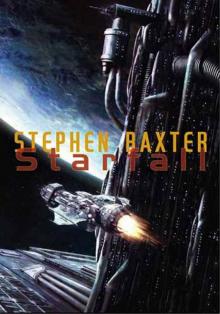 Starfall
Starfall Doctor Who - The Wheel of Ice
Doctor Who - The Wheel of Ice Longtusk
Longtusk Silverhair
Silverhair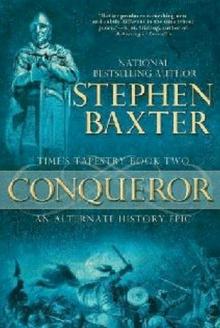 Conqueror tt-2
Conqueror tt-2 Flood
Flood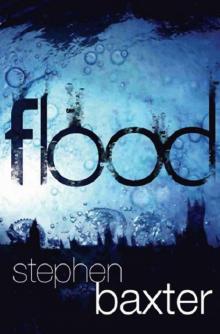 Flood f-1
Flood f-1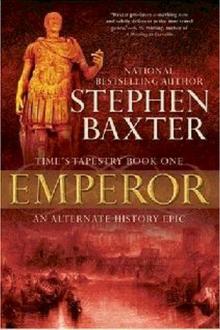 Emperor tt-1
Emperor tt-1 Moonseed
Moonseed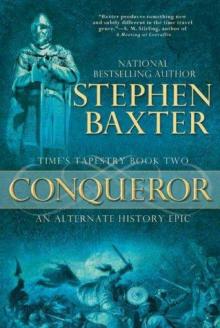 Conqueror
Conqueror Timelike Infinity xs-2
Timelike Infinity xs-2 The Ghost Pit
The Ghost Pit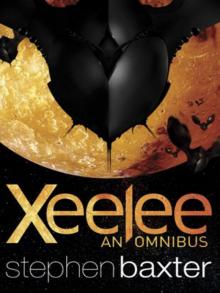 Xeelee: An Omnibus: Raft, Timelike Infinity, Flux, Ring
Xeelee: An Omnibus: Raft, Timelike Infinity, Flux, Ring Weaver tt-4
Weaver tt-4 Landfall: Tales From the Flood/Ark Universe
Landfall: Tales From the Flood/Ark Universe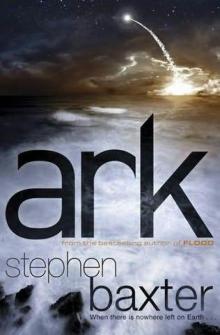 Ark
Ark Emperor: Time’s Tapestry Book One
Emperor: Time’s Tapestry Book One Space
Space Icebones
Icebones Manifold: Space
Manifold: Space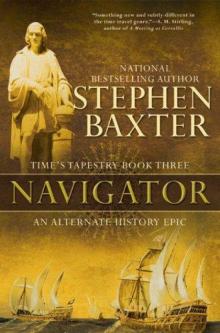 Navigator
Navigator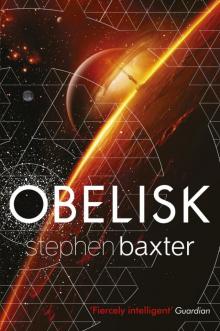 Obelisk
Obelisk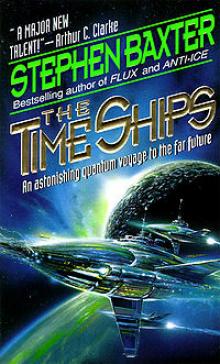 The Time Ships
The Time Ships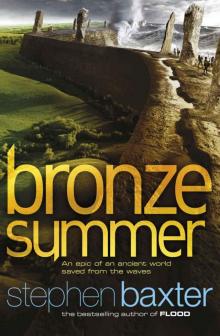 Bronze Summer
Bronze Summer Resplendent
Resplendent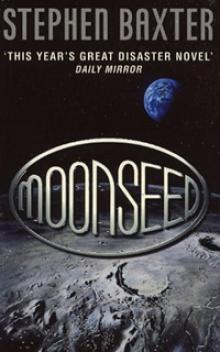 Moonseed n-3
Moonseed n-3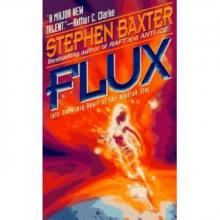 Flux xs-3
Flux xs-3 Transcendent dc-3
Transcendent dc-3 Icebones tm-3
Icebones tm-3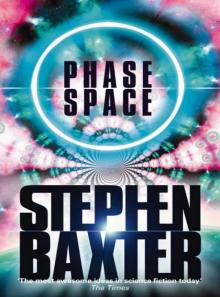 Phase Space
Phase Space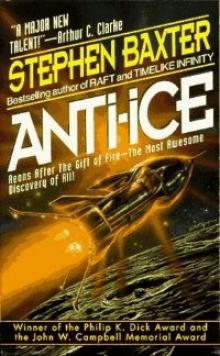 Anti-Ice
Anti-Ice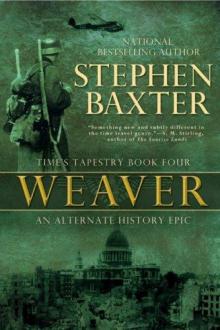 Weaver
Weaver Voyage
Voyage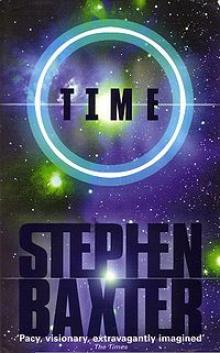 Time m-1
Time m-1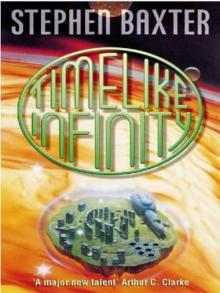 Timelike Infinity
Timelike Infinity Exultant dc-2
Exultant dc-2 Coalescent dc-1
Coalescent dc-1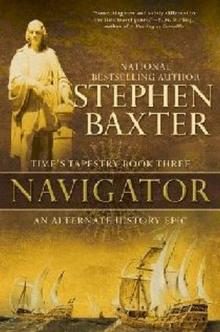 Navigator tt-3
Navigator tt-3